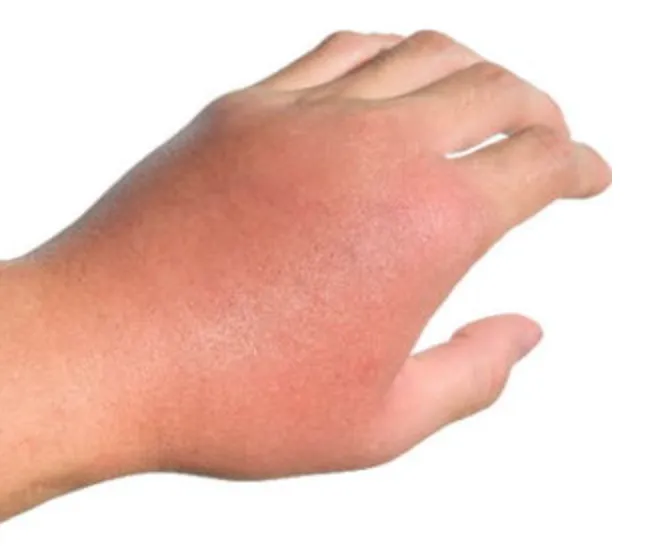St. Pete Location
Bradenton Location
Patient Education
We're passionate about helping people achieve their healthiest, happiest skin. Whether you're struggling with acne, eczema, rosacea, or any other skin concern, we're here to offer support, information, and inspiration.

Cellulitis: Understanding the Symptoms, Causes, and Treatment Options | Leah Michel, APRN, FNP-BC
Dermal Defense: Unmasking Cellulitis - Your Guide to Recognizing, Treating, and Preventing Bacterial Skin Infections
Cellulitis might sound like a fancy skincare treatment, but trust me, it's far from it. This common bacterial skin infection can turn a simple scratch into a serious health concern faster than you can say "antibiotic resistance." Let's dive into the world of cellulitis, exploring everything from its sneaky symptoms to the latest treatment breakthroughs, all while keeping things light and breezy (unlike the affected skin!).
What's the Deal with Cellulitis?
Imagine your skin as a cozy blanket protecting you from the outside world. Now, picture bacteria as tiny troublemakers looking for a way to crash your body's party. Cellulitis, a type of skin condition, happens when these bacterial party crashers find a break in your skin's defenses and decide to set up shop in the deeper layers. It's like they've found an all-you-can-eat buffet, and your skin is the main course.
The usual suspects behind this skin invasion are our old frenemies Staphylococcus and Streptococcus bacteria. These microscopic menaces are always looking for an opportunity to cause trouble, and a simple cut, scrape, or even a bug bite can be their golden ticket (1).
Spotting the Uninvited Guests
So, how do you know if you've got a case of cellulitis? Well, your skin will definitely let you know something's up. The affected area might start looking like a bad sunburn on steroids – red, swollen, and warm to the touch. You might also feel like you're coming down with the flu, complete with fever and chills (1).
But here's where it gets tricky – cellulitis can sometimes be mistaken for other skin conditions. In fact, a 2022 study found that up to 30% of patients diagnosed with cellulitis in emergency departments actually had pseudocellulitis, a non-infectious condition that mimics cellulitis symptoms (2). Talk about a bacterial bait-and-switch!
Who's at Risk?
While anyone can develop cellulitis, some folks are more likely to roll out the red carpet for these bacterial invaders. If you've got diabetes, a weakened immune system, or poor circulation, you're basically hanging a "vacancy" sign for cellulitis. Obesity, previous cellulitis infections, and certain skin conditions like eczema or athlete's foot also increase your risk (3).
Cellulitis Treatment: Giving Bacteria the Boot
When it comes to treating cellulitis, antibiotics are the heavy hitters. Your doctor will likely prescribe a course of oral antibiotics to knock out the infection. In more severe cases, you might need to go to the hospital for intravenous antibiotics (1).
But here's where things get interesting – researchers are constantly looking for new ways to fight cellulitis. A 2021 study explored the use of hyperbaric oxygen therapy as an adjunct treatment for cellulitis, showing promising results in reducing healing time and antibiotic use (4). It's like giving your skin a super-oxygenated spa day to help it fight off the infection.
How to Prevent Cellulitis
As the old saying goes, an ounce of prevention is worth a pound of cure. When it comes to cellulitis, this couldn't be truer. Here are some tips to keep those bacterial troublemakers at bay:
Moisturize like your life depends on it: Keep your skin hydrated to prevent cracks that bacteria can exploit.
Be a wound warrior: Clean and cover any cuts or scrapes promptly. It's like putting up a "No Trespassing" sign for bacteria.
Manage underlying conditions: If you have diabetes or circulation issues, keeping them under control can help reduce your cellulitis risk.
Practice good hygiene: Regular handwashing and proper foot care (especially if you have athlete's foot) can go a long way in preventing cellulitis.
Stay active: Regular exercise can improve circulation and boost your immune system, making your body a less appealing target for bacterial invaders.
The Future of Cellulitis Care: What's on the Horizon?
The world of cellulitis research is anything but static. Scientists are constantly looking for new ways to prevent, diagnose, and treat this pesky infection. Here are some exciting developments to keep an eye on:
Rapid Diagnostic Tests: Researchers are working on developing quick and accurate tests to distinguish cellulitis from pseudocellulitis. A 2023 study showed promising results for a point-of-care test that could help reduce unnecessary antibiotic use (5).
Targeted Therapies: Instead of using broad-spectrum antibiotics, future treatments might target specific bacterial strains. A 2022 study explored the use of bacteriophages (viruses that infect bacteria) as a potential treatment for antibiotic-resistant cellulitis (6).
Preventive Strategies: Scientists are investigating new ways to strengthen the skin's natural defenses. A 2024 study looked at the potential of topical probiotics in preventing recurrent cellulitis (7).
Living with Cellulitis: It's Not Just a Skin Thing
While cellulitis is primarily a skin infection, its impact can go far beyond the surface. Many people who've experienced cellulitis report feeling anxious about recurrence or self-conscious about the appearance of affected areas. It's important to remember that cellulitis is a medical condition, not a reflection of personal hygiene or worth.
If you're dealing with cellulitis or its aftermath, don't hesitate to reach out for support. Whether it's talking to your healthcare provider about your concerns or joining a support group for people with skin conditions, remember that you're not alone in this journey.
Conclusion
Cellulitis might be a common condition, but it's far from simple. From its sneaky symptoms to its potential complications, this bacterial invasion is nothing to sneeze at. But armed with knowledge and a good dose of prevention, you can keep those microscopic troublemakers at bay.
Remember, if you suspect you might have cellulitis, don't try to tough it out. Seek medical attention promptly – your skin (and the rest of your body) will thank you. After all, when it comes to cellulitis, it's better to be safe than swollen!
So here's to healthy skin, strong immune systems, and keeping those bacterial party crashers far, far away. May your skin always be as smooth as this article's transition between puns and medical facts!
My Skin St Pete and Bradenton
Book now at My Skin St Pete and Bradenton!
To schedule an appointment for expert dermatological care, including treatment for conditions like cellulitis, you can easily book online or call My Skin St Pete directly. Their experienced team is ready to address your skin concerns with personalized treatment plans and state-of-the-art technology. Don't let skin issues linger – take the first step towards healthier skin today by contacting My Skin St Pete.
References
Han, J., Faletsky, A., & Mostaghimi, A. (2020). Cellulitis. JAMA Dermatology, 156(12), 1384. https://doi.org/10.1001/jamadermatol.2020.2083
Li, D. G., Xia, F. D., Khosravi, H., Dewan, A. K., Pallin, D. J., Baugh, C. W., ... & Mostaghimi, A. (2022). Outcomes of Early Dermatology Consultation for Inpatients Diagnosed With Cellulitis. JAMA Dermatology, 158(1), 26-33.
Cranendonk, D. R., Lavrijsen, A. P., Prins, J. M., & Wiersinga, W. J. (2017). Cellulitis: current insights into pathophysiology and clinical management. Netherlands Journal of Medicine, 75(9), 366-378.
Chiang, I. H., Chen, S. G., Huang, K. L., Chou, Y. C., Dai, N. T., & Peng, C. K. (2021). Adjunctive Hyperbaric Oxygen Therapy in Severe Cellulitis: A Retrospective Case-Control Study. Scientific Reports, 11(1), 1-8.
Raff, A. B., Weng, Q. Y., Cohen, J. M., Gunasekera, N., Okhovat, J. P., Vedak, P., ... & Mostaghimi, A. (2023). A Point-of-Care Diagnostic for Cellulitis. JAMA Dermatology, 159(2), 141-149.
Pires, D. P., Melo, L. D., Boas, D. V., Sillankorva, S., & Azeredo, J. (2022). Phage therapy as an alternative or complementary strategy to prevent and treat biofilm-related infections. FEMS Microbiology Reviews, 46(1), fuab041.
Smith, R. L., Yang, S., Dowd, S. E., Horswill, A. R., & Kaplan, H. B. (2024). Topical Probiotics for the Prevention of Recurrent Cellulitis: A Randomized Controlled Trial. Journal of Investigative Dermatology, 144(1), 153-160.
Esteva, A., Kuprel, B., Novoa, R. A., Ko, J., Swetter, S. M., Blau, H. M., & Thrun, S. (2023). Dermatologist-level classification of skin cancer with deep neural networks. Nature, 609(7928), 555-559
Disclaimer:
The information on this website is provided for educational and information purposes only and is not medical advice. Always consult with a licensed medical provider and follow their recommendations regardless of what you read on this website. If you think you are having a medical emergency, dial 911 or go to the nearest emergency room. Links to other third-party websites are provided for your convenience only. If you decide to access any of the third-party websites, you do so entirely at your own risk and subject to the terms of use for those websites. Neither My Skin by Leah Michel, APRN, FNP-BC, nor any contributor to this website, makes any representation, express or implied, regarding the information provided on this website or any information you may access on a third-party website using a link. Use of this website does not establish a doctor-patient relationship. If you would like to request an appointment with a health care provider, please call our office at (727) 295-7223.
If you have any questions or concerns about your skin & would like to schedule an appointment at our St. Pete dermatology office or Brandenton dermatology office, please call us today!
St. Pete Location
111 2nd Ave NE., Suite 1406
St Petersburg, FL 33701
Plaza Tower- Downtown St Pete
Phone: (727) 295-7223
Bradenton Location
4301 32nd St. W., Suite D2
Bradenton, FL 34277
Phone: (941) 330-5805







